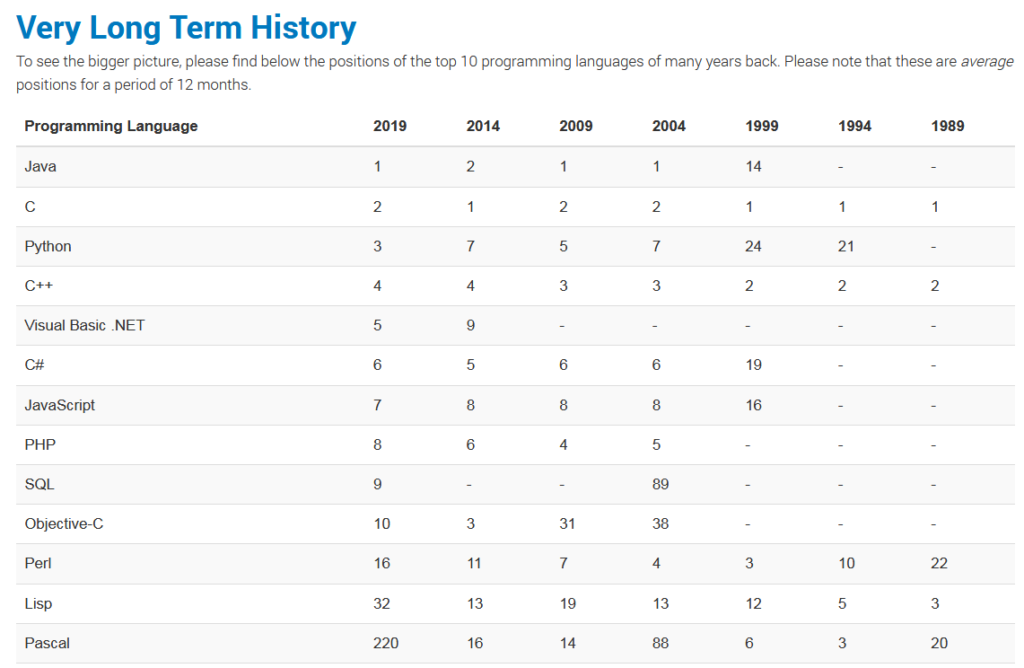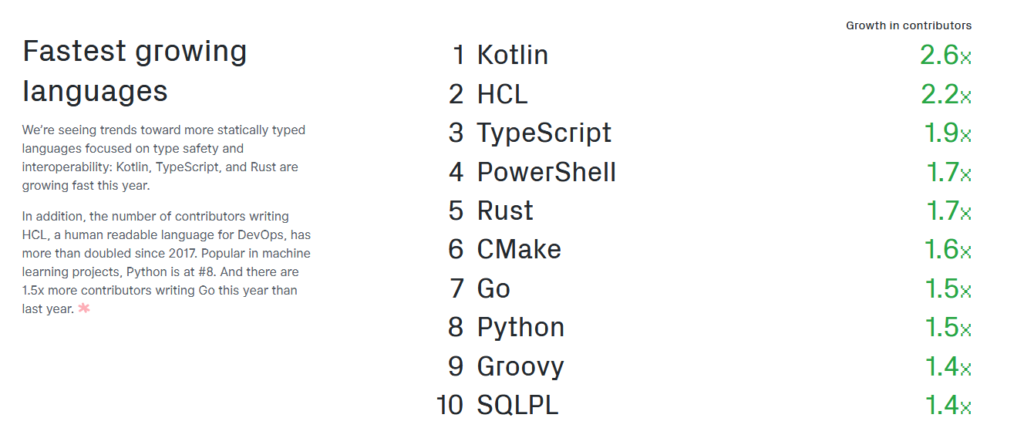A Look TOP 5 of the Most Popular Programming Languages
The Top Programming Languages, Explained
What makes the top programming languages so popular? We’ll take a deeper look at five of the top languages to learn how they’re used and why people love them.1. Java
According to Tiobe, Java has been the number 1 or 2 most popular language basically since its creation in the mid-90s. Many of the world’s biggest companies use Java to build desktop apps and backend web systems.If you know Java, chances are you won’t be desperate for work!
There are a number of factors that make Java so popular:
- Portability: Thanks to the platform-agnostic Java Virtual Machine (JVM), Java can run on nearly every system. Java is also the most popular Android language, so the vast majority of Android apps are built in Java.
- Scalability: James Governor has a saying: “When web companies grow up, they become Java shops”.Java is built for scalability in mind, which is why it is so popular among enterprises and scaling startups (Twitter moved from Ruby to Java for scaling purposes). Since Java is a statically-typed language, it’s faster and easier to maintain with less bugs. It is also backwards compatible, which means old versions of the language will still run perfectly even after new versions are released. This is a big relief for businesses who would otherwise worry about rewriting their code every time a new version comes out.
- Large community: The popularity of Java helps to ensure its future popularity, thanks to a huge community of users. With massive Stack Overflow and GitHub communities, developers can find help on virtually any problem they might encounter. Coupled with its portability, developers know that investing in Java will pay dividends for a long, long time.
2. The C Programming Language
C is one of the oldest, most popular programming languages, thanks to its near universal portability and early adoption by Tech’s biggest brands, including Microsoft, Apple, Linux, and Oracle.C is also the most popular language for embedded systems in cars, electronics, and other devices.
Nearly everything that we touch today, from our cell phones to alarm clocks, is influenced by—if not directly written in—the C language.
Why is it still a popular programming language to learn today? First, it’s essentially a portable assembly language. It works with nearly every system and operates about as low to the machine as you can get.
C also has features that make is perfectly qualified for operating systems and embedded systems (like your car’s dashboard). Thanks to its relatively small runtime, C is perfect for keeping these systems lean.
Any programmer will benefit from learning the C language.
Many algorithms written and shared online are done in C. It’s essentially the “universal language” of programming languages. C spinoffs like C++ and C# are also among the top 5 most popular languages, again emphasizing the influence C still has today.

3. Python
The popularity of Python has risen steadily over the past 15 years, finally breaking the top 5 on the Tiobe Index a few years ago. This is because Python is a major language in some of the most exciting technologies today.It’s surprising how simple Python is to learn.
It’s now the most popular introductory language taught in universities and often picked up by experienced developers as a second or third language.
4. JavaScript
Thanks to the ubiquity of web browsers, JavaScript has become one of the most popular programming languages in the world, and number 1 on GitHub in terms of pull requests.There are notable complaints with JavaScript (more on that in a bit), but JavaScript has held its own against newer languages and will continue to play a significant role on the web.
JavaScript allows developers to add interactive effects to web pages. It often works alongside HTML, but it’s becoming more common for web apps to be built entirely in JavaScript.
Because of its simplicity and speed, more startups and tech businesses are starting to use JavaScript on the backend via the Node.js framework.
5. Ruby
Ruby is one of the most popular languages among tech startups.Many Silicon Valley unicorns have been built on Ruby, including Airbnb, Twitch, GitHub, and Twitter. Its popularity is bolstered (and perhaps dependent) on Ruby on Rails, a full-stack web application framework that runs Ruby.
Ruby is beloved by developers for a number of reasons.
- First, Ruby has an incredibly simple beautiful syntax that allows a developer to do more with less code.
- Second, thanks to Ruby on Rails, getting a web application up-and-running takes less time than in other frameworks.
The downside of Ruby is its scalability.
Ruby is a dynamically-typed language, which makes it very flexible and great for prototypes, but difficult to maintain at scale. As a Ruby app grows, the dynamic nature of the language obscures the source of code errors and eats up computing resources. This is why Twitter switched from Ruby to Java.
2020 Programming Language Predictions
Now that we’ve looked at the most popular programming languages right now, we’re going to take the liberty of predicting what’s to come in 2020 and beyond.Based on trends from previous years, we’re confident that the list of top programming languages won’t change that much from year-to-year.
But where are the winds headed? Let’s try to take a glimpse into the future.
Fastest-Growing Languages
Every year, the Tiobe Index crowns the fastest growing language as “Language of the Year”. Recent winners have been Python (2018), C (2017), Go (2016), Java (2015), and JavaScript (2014).Tiobe will crown a new Language of the Year in the next few weeks, but their website says the candidates are Kotlin and C. It’s an interesting dichotomy with C being of the oldest languages (1987) and Kotlin being one of the newest (2011).
Let’s look at each language.
Kotlin

And, as you can see in the image above, GitHub’s report indicates that Kotlin was the fastest growing language in 2018.
There are several reasons for Kotlin’s rise in popularity, not least of which is its 100-percent interoperability with Java and the fact that IT runs on Java Virtual Machine (Java is another official Android language).
Kotlin also compiles down into JavaScript, making it extremely versatile for both front and back-end development.
Expect to hear a lot more about Kotlin in the years to come, and if possible, take some time to add it to your repertoire
The C Programming Language
We’ve already discussed why C practically runs the world, but what’s behind this latest boost in popularity?Like we mentioned earlier, C is the perfect language for embedded systems, and frankly, everything is becoming an embedded system these days.
C is one of the top programming languages for IoT devices, including wearables and car dashboards. As more products become “smart”, we’ll see C’s use continue to expand.
Most Influential Programming Languages
The popularity of a programming language is one thing, but which languages will have the greatest influence in the years to come?One way to determine whether a language is “influential” is to look at the technologies built on top of it (see Python and C).
Another way is to look at a language’s ability to solve intrinsic software problems. For the sake of treading new ground, let’s focus on the latter definition.
I turned to Jake Ehrlich, a software engineer and programming language enthusiast, for his thoughts on the most influential programming languages.
“Individual problems tend to be more influential than any one specific language,” said Ehrlich. “Right now the biggest problem we’re facing is end of Moore’s law.”
Moore’s Law says that computing power will double every 18 months, and for the first time in decades, computer chip makers are not keeping pace. That means software developers need to figure out a way to make powerful web applications with the same amount of computing processing power.
Another hardware issue Ehrlich references is power consumption.
“Batteries just aren’t getting better,” said Ehrlich, despite the fact that more and more of our devices run on them. “So now we need to make hardware and software that is as power-efficient as possible.”
One solution to both of these challenges, Ehrlich suggests, is the use of native languages. “It turns out that the same sort of features that improve speed and responsiveness also allow us to write more power-efficient code.”
Ehrlich thinks we will see a move towards native languages like Go, Swift, Rust as hardware attempts to catch up.
Learn the Most Popular Programming Languages
The world’s biggest challenges and opportunities are driven by programming languages discussed in this article.While this post is all about the code, it is really an ode to the people who create that code day-in and day-out. From machine learning to cybersecurity and web apps to battery power, these technologies will only go as far as software developers take them.
Comments
Post a Comment